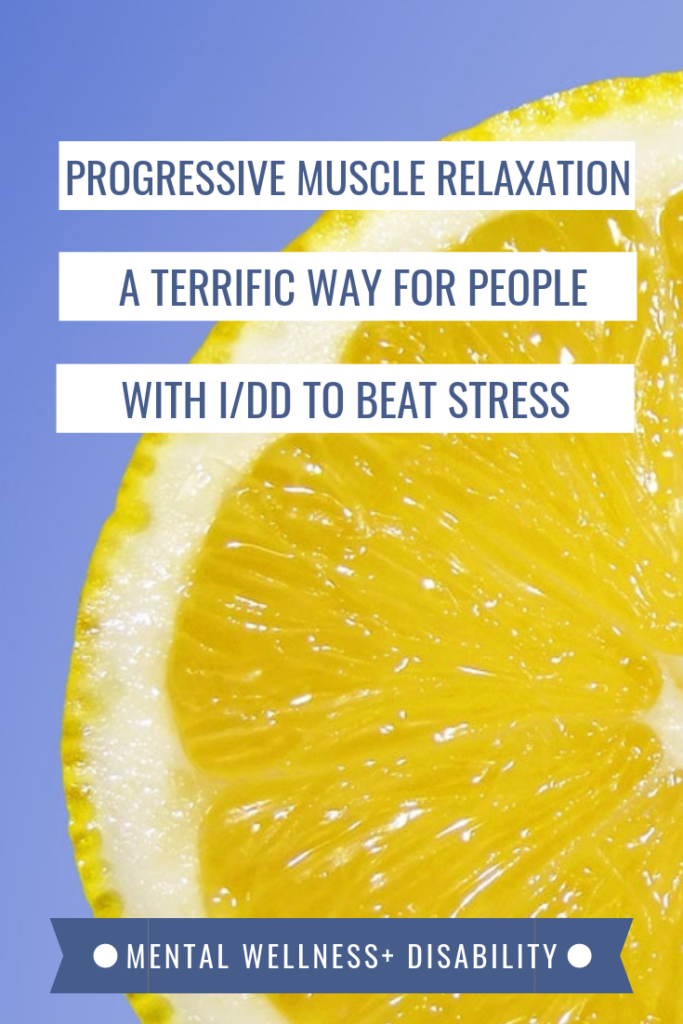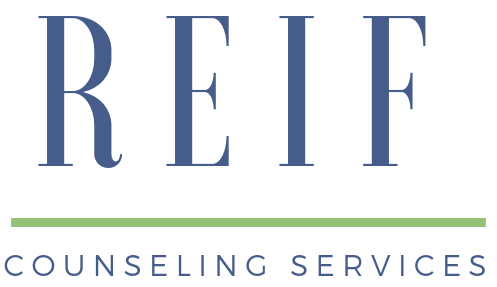What is progressive muscle relaxation?
Progressive Muscle Relaxation is a simple technique aimed at achieving relaxation and reducing anxiety and physical pain. It is low risk, easy to learn, and can be self-led at home or almost anywhere! It’s a great relaxation technique, and I often suggest it to my counseling clients with Autism, Down syndrome, and other developmental disabilities. The technique involves two basic steps:
- Intentionally tensing the muscles of one body part for a set amount of time, and then
- Releasing the tension
The idea is that, by causing tension and then releasing it, a person can:
- Learn to recognize when their body is tense (which might be a sign of rising anxiety or other agitation)
- Become confident in their ability to release tension and achieve physical relaxation

Why is progressive muscle relaxation a good relaxation technique for people with disabilities?
Success comes from physical, not intellectual, understanding
This technique is basically a way to use your body to learn to calm your mind , which can be really helpful for people with cognitive limitations.
My counseling clients with developmental disabilities may not always recognize when they are feeling psychological symptoms of anxiety or distress. Concepts like ‘uneasiness’, ‘panic’, and ‘avoidance’ can be vague and difficult to grasp for some people with intellectual barriers to understanding.
By contrast, the difference between a clenched fist and a relaxed hand is visible, tangible, and memorable. It is an accessible difference to understand for nearly everyone, regardless of disability.
Once someone learns to feel the difference between the physical states of tension and relaxation, they are better equipped to know when they are becoming tense. If they’ve been practicing Progressive Muscle Relaxation, they will have confidence that they can release the tension and achieve relaxation.
When adapted for people with disabilities, it can be extremely clear and concrete
Many relaxation techniques rely on vague language… “clear your mind” is an instruction that just does not work for many people with Autism, ADHD, or Down syndrome!
In many available Progressive Muscle Relaxation scripts, you’ll see this kind of language used as well.
Unlike many other relaxation techniques, though, Progressive Muscle Relaxation can be easily modified for people with I/DD. A therapist can present the steps as a series of physical ‘to-do’s’, rather than abstract, difficult to understand concepts.
Consider the instruction “make your foot muscles as tight as you can”. You could instead ask someone to imagine they’re holding a pencil under their foot, and they need to curl their toes to keep it from dropping. You could even have them physically do this the first few times they practice until they learn what the sensation should feel like.
It is an active relaxation technique
Anecdotally, I’ve found that many of my clients have learned other, more passive relaxation techniques in the past. Deep breathing, guided imagery, and body scanning are the ones that I hear about most often.
Many of my clients, especially those with Autism Spectrum Disorders, have experienced a paradoxical effect when exposed to these ‘quieter’ relaxation techniques. Rather than feel calm and comforted as a result of using a relaxation technique, they instead feel increased anxiety, sometimes to the point of panic.
Progressive Muscle Relaxation, maybe because it is a more physically active technique, seems less likely to cause the unwanted anxiety that is a rare but known possible effect of relaxation practice.
Risks of Progressive Muscle Relaxation for People with Disabilities
The risk for physical injury using this technique is quite low. I still recommend that anyone using Progressive Muscle Relaxation, regardless of whether or not they have a disability, be reminded at the start of each session to avoid tensing muscles which are sore, or which cause them pain.
Of course, because people with disabilities can have very unique responses to pain and expressions as a result of pain, I always recommend that someone who knows the person very well be with them as they do Progressive Muscle Relaxation, just to be certain that the technique isn’t causing any undue physical strain.
Just know that it is completely fine to skip over parts of the body because of temporary injury, permanent physical limitation, or plain old discomfort.
How do you do Progressive Muscle Relaxation?
To begin, give yourself the best opportunity to achieve deep relaxation by sitting in a comfortable chair, in a room with no distractions (including no background music). Take off your shoes, too.
Allow plenty of time; in the beginning, it will probably take around 20 minutes to do a full course of Progressive Muscle Relaxation.
Start by taking 5 deep, cleansing breaths. If you want more guidance on how to help someone with intellectual disabilities learn to do deep breathing, you might want to read this post.
Then, focus on each of these body parts in the following order. Begin by making the area as tense as possible, and holding the tension for eight seconds. Then, release the tension, and take another eight to ten seconds to notice how the relaxed muscles feel differently than the tensed muscles did.
Right foot – Curl toes downward
Right lower leg– Pull toes upward toward the ceiling
Right upper leg – Tighten thigh
Left foot – Curl toes downward
Left lower leg and foot – Pull toes upward toward the ceiling
Left upper leg – Tighten thigh
Right forearm and hand – Make a fist
Right upper arm – Bring hand to shoulder and tighten bicep and tricep muscles
Left forearm and hand – Make a fist
Left upper arm – Bring hand to shoulder and tighten bicep and tricep muscles
Hips and Buttocks– Squeeze buttock muscles
Abdomen and chest – Inhale deeply and hold the breath in your lungs
Neck – Slowly look up to the ceiling and tense muscles in the neck
Back– Hold shoulder blades together as tightly as possible
Shoulders – Bring shoulders up toward ears
Forehead – Raise eyebrows as high as possible
Eyes and Cheeks– Clench eyes shut
Mouth and jaw – Open mouth as wide as possible
To make the sequence totally understandable to people with disabilities, I will sometimes include an ‘as if’ instruction for each body part if I see that it could be helpful. For example, I might ask a client to squeeze their right hand “as if” they’re squeezing a lemon if I see that they’re extending their fingers outward rather creating a fist, which is better for achieving full tension.
The trickiest part of Progressive Muscle Relaxation is being sure to ONLY tense the area you’re focusing on. Try to tighten just your right thigh without tightening your buttocks as well; not so easy, is it?! With practice, this will become more natural, I promise!
When and How to Practice Progressive Muscle Relaxation
As with all relaxation techniques, this one is best practiced when you are fully relaxed. Jumping ahead and expecting any technique to work before you fully trust that it will is almost guaranteeing that it won’t work, now or ever.
Especially for people with disabilities, it can take weeks or even months of rote practice before a relaxation technique is really working for them. Allow that time, and don’t rush things.
I recommend practicing Progressive Muscle Relaxation at least twice per day, ideally once before breakfast or lunch, and once closer to bedtime. Just not while in bed at bedtime; I don’t care how dedicated you are to your practice; you’re going to fall asleep!
It’s best not to do Progressive Muscle Relaxation just after a meal, so that digestion isn’t disturbed.
Want to know more?
Here are links to a few interesting articles focusing on Progressive Muscle Relaxation for people with Disabilities.
This case study describes the effects of Progressive Muscle Relaxation for a young boy with Autism.
This article is one of many that examines the use of the ‘Feeling Good’ program. This program is a Cognitive Behavioral Therapy based group designed for people with intellectual disabilities who are experiencing chronic pain. Progressive Muscle Relaxation is one of a a number of relaxation techniques introduced by this program.
This older article (complete with outdated disability language!) is a review of relaxation techniques based on their usefulness in Special Education Classroom settings.
I hope this is helpful to you!
Have you tried Progressive Muscle Relaxation, or do you have questions about it?
Leave a comment and let me know, I’d love to hear from you!
Keep reading
Other posts you may be interested in
How to Know if Someone is a Real Friend. A Quiz for Teens and Adults with IDD.
In my counseling practice, I offer mental health counseling for teens and adults with IDD. Many of my clients who have Down syndrome, Cerebral palsy, and other disabilities have lots of meaningful friendships in their lives. But sometimes, they ask “how can I know if someone is a real friend?” Maybe you have a friend […]











